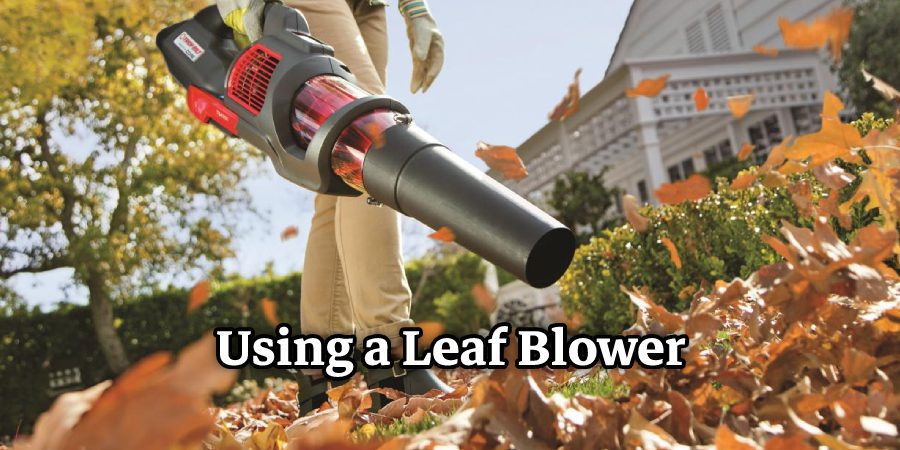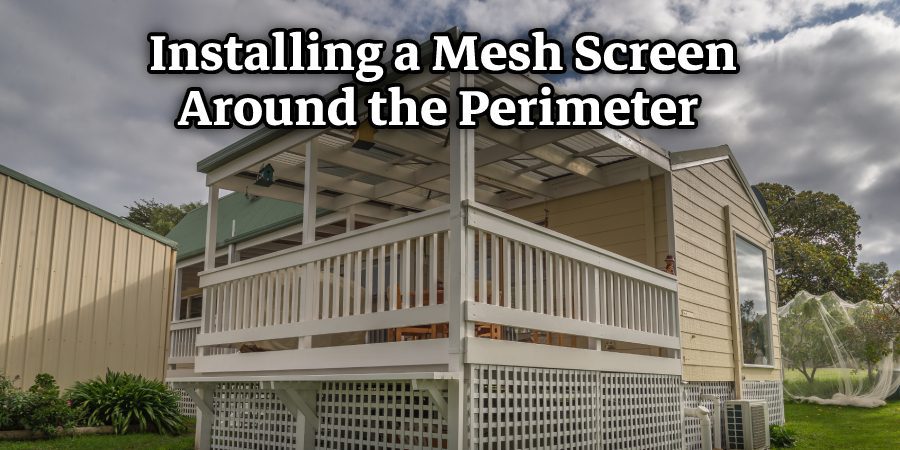If you have a deck, you know how frustrating it can be to constantly sweep away leaves and debris that accumulate underneath. Not only is it unsightly, but it can also cause damage to your deck if left unchecked for too long. Fortunately, there are several ways to keep leaves from under your deck and maintain a clean outdoor space.
By following the strategies outlined in this blog post, you can keep leaves away from your deck. From installing a barrier to using leaf blowers or rakes, we’ve got you covered with tried and true methods that will help how to keep leaves from under deck.
Step By Step Guide How To Keep Leaves From Under Deck
Decks are a great addition to any home, providing an outdoor space for relaxation, entertainment, and enjoyment of the beautiful surroundings. However, one common problem that deck owners face is leaves accumulating beneath their decks. Not only can this affect the aesthetic appeal of your yard, but it can also create a breeding ground for pests and mold, which may cause damage to your deck over time. Fortunately, there are several ways to keep leaves from under your deck, and in this blog post, we will discuss some of the most effective methods.
Install a Deck Skirt
One of the simplest and most effective ways to keep leaves from accumulating beneath your deck is by installing a deck skirt. A deck skirt is essentially a barrier that is installed around the perimeter of your deck, which prevents debris from collecting underneath the deck. The skirt can be made from a variety of materials including wood, vinyl, or composite, and can be customized to match the style of your deck.
To install a deck skirt, begin by measuring the length and height of each section of your deck that you want to cover. Cut the skirting material to size and attach it to the underside of the deck using screws or adhesives. Be sure to leave a small gap between the bottom of the skirt and the ground to allow for ventilation and drainage.

Use Leaf Guards
Another option for keeping leaves from under your deck is to install leaf guards. These are essentially screens that are placed over the openings in your deck’s floorboards, preventing debris from falling through. There are several types of leaf guards available, including mesh screens and solid covers, so you can choose the type that best suits your needs and preferences.
To install leaf guards, simply place them over the openings in your deck’s floorboards and secure them with screws or clips. Be sure to clean the guards regularly to ensure that they remain effective.
Trim Overhanging Trees and Shrubs
If you have trees or shrubs that overhang your deck, they may be contributing to the leaf accumulation problem. To address this issue, consider trimming back any overhanging branches or foliage. This will not only help keep leaves from falling onto your deck but will also improve the overall health of the plants by allowing more sunlight and air circulation.
To ensure the health of your plants, be sure to take proper pruning techniques when trimming trees and shrubs. If you have any questions about this process, contact a professional landscaper for assistance.
Use a Leaf Blower or Rake
If all else fails, you can always resort to good old-fashioned manual labor. Using a leaf blower or rake to regularly remove leaves from beneath your deck can help prevent a buildup of debris. Despite being a more thorough process than the others, this method is easy to execute and results in a clean and tidy deck area.

Install gutter guards to prevent leaves from falling onto the deck
Installing gutter guards is a great way to prevent leaves and debris from falling onto your deck and accumulating underneath it. Gutter guards are designed to fit over the top of your gutters, creating a barrier that prevents leaves and other debris from entering the gutter system.
To install gutter guards, follow these steps:
Clean out your gutters – Before installing gutter guards, it’s important to clean out your gutters to remove any existing debris.
Measure your gutters – Use a tape measure to determine the length of your gutters. This will help you determine how many gutter guards you’ll need to purchase.
Purchase gutter guards – You can find gutter guards at most home improvement stores or online. Make sure to choose a type that’s compatible with your gutters.
Install the gutter guards – Start at one end of your gutter system and place the first piece of gutter guard over the top of the gutter. Secure it in place using the provided clips or screws. Continue working your way across the gutter system until all gutter guards are installed.
By following these steps, you can effectively prevent leaves and other debris from falling onto your deck and accumulating underneath it.
Sealing gaps and cracks in the deck to keep leaves from accumulating underneath
Sealing gaps and cracks in your deck is another effective way to keep leaves from accumulating underneath. Leaves and other debris can easily find their way through small gaps and cracks, so sealing these areas can help prevent this from happening.
To seal gaps and cracks in your deck, follow these steps:
Clean the deck – Before sealing any gaps or cracks, it’s important to clean the deck to remove any existing debris or dirt.
Inspect the deck – Walk around the deck and inspect it for any gaps or cracks that could allow leaves or debris to enter. Make a note of any areas that need attention.
Purchase sealant – You can find deck sealant at most home improvement stores. Choose a type that’s designed for outdoor use and is compatible with the material your deck is made of.
Apply sealant – Using a caulking gun, apply the sealant to the gaps and cracks you identified earlier. Smooth the sealant out with a putty knife or similar tool.

Let dry – Allow the sealant to dry completely before using the deck again.
By sealing gaps and cracks in your deck, you can significantly reduce the amount of leaves and debris that accumulates underneath.
Using landscaping and plantings to redirect falling leaves away from the deck area
Landscaping and plantings can also be used to redirect falling leaves away from the deck area, which can help prevent them from accumulating underneath.
To use landscaping and plantings to redirect falling leaves, follow these steps:
Evaluate your yard – Take a look at your yard and identify areas where leaves tend to accumulate. This will give you an idea of where to focus your landscaping efforts.
Plant trees strategically – Consider planting trees in areas that are upwind from your deck, so that falling leaves will be blown away from the deck. You can also plant trees or shrubs around the perimeter of your yard to create a windbreak that will help redirect the flow of leaves.
Add ground cover – Ground cover plants such as ivy or vinca can help trap leaves before they reach your deck. Plant these types of ground cover plants in areas that are prone to leaf accumulation.
Use mulch – Mulch can be used to cover bare soil areas in your yard. This can help prevent the growth of weeds and make it easier to collect fallen leaves.
Regularly clean up – Even with landscaping and plantings, some leaves may still find their way onto your deck. Make sure to regularly clean up any fallen leaves to prevent them from accumulating.
By using landscaping and plantings strategically, you can redirect falling leaves away from your deck and prevent them from accumulating underneath.
Adding a ground cover or gravel layer underneath the deck to prevent leaf buildup
Adding a ground cover or gravel layer underneath the deck is another effective way to prevent leaf buildup. By creating a barrier between the deck and the ground, you can prevent leaves and other debris from accumulating in this area.
To add a ground cover or gravel layer underneath your deck, follow these steps:
Clean the area – Before adding any type of ground cover or gravel, it’s important to clean the area underneath your deck. Remove any existing debris or dirt.

Choose a ground cover or gravel – You can choose from a variety of ground cover options such as landscape fabric, wood chips, or decorative rocks/gravel. Consider the aesthetic appeal of each option as well as its practicality.
Lay down the ground cover or gravel – Once you’ve chosen your ground cover or gravel, lay it down evenly underneath the deck. Make sure the entire area is covered.
Secure the ground cover or gravel – If necessary, use landscape staples or similar hardware to secure the ground cover or gravel in place.
By adding a ground cover or gravel layer underneath your deck, you can effectively prevent leaf buildup in this area. Additionally, this can help improve the overall look of your yard by creating a more visually appealing space.
Tips for maintaining a leaf-free deck throughout the year
Regularly sweep your deck – One of the easiest ways to prevent leaves from accumulating on your deck is to regularly sweep it with a broom or leaf blower. This should be done at least once a week during the fall season when leaves are falling more frequently.
To keep your gutters clear of leaves and other debris, consider installing gutter guards. This can help ensure that rainwater flows freely away from your deck and doesn’t contribute to leaf buildup.
Trim overhanging trees – Overhanging trees can be a major source of leaves on your deck. Consider trimming back any branches that hang over your deck to reduce the amount of leaves that fall onto it.
Use a leaf blower – In addition to sweeping your deck, you can also use a leaf blower to easily remove leaves and other debris. This can be especially useful if you have a large deck or a lot of trees in your yard.
Install a mesh screen – If your deck is elevated, consider installing a mesh screen around the perimeter to prevent leaves and other debris from blowing underneath. This can be an effective way to keep leaves out from under your deck.

By following these tips, you can maintain a leaf-free deck throughout the year and enjoy a clean and tidy outdoor living space.
Conclusion
Maintaining the appearance and longevity of your deck is crucial, and preventing leaf buildup under it is a vital task. By using one or more of the methods discussed above, you can ensure that your deck remains free of debris and in good condition for years to come. As with any outdoor home improvement project, be sure to follow safety guidelines and exercise caution when working on or around your deck.
Professional Focus:
Arden Bernier is dedicated to exploring and advancing patio design and maintenance, combining practical knowledge with innovative solutions. Specializing in outdoor living spaces, he provides expert advice on patio fixes, landscaping, and sustainable outdoor design. With a focus on creating functional, aesthetic, and durable outdoor environments, Arden empowers homeowners to transform their patios into beautiful and relaxing retreats.
Vision:
To inspire and assist homeowners in creating functional, aesthetically pleasing outdoor spaces. Arden encourages creativity and practical problem-solving in patio design, making outdoor living more accessible and enjoyable for everyone.
Education:
- Bachelor of Arts (BA) in Environmental Design – University of California, Berkeley.
- Master of Science (MS) in Landscape Architecture – University of Southern California.
- Specialized training in sustainable landscape design, outdoor space planning, and eco-friendly materials.
Recognition:
- Author at PatioFixes.com, providing expert advice on patio maintenance and design.
- Featured in online platforms and home improvement blogs for valuable tips on patio fixes and outdoor living.
- Recognized for his contributions to making outdoor spaces more eco-friendly and sustainable.
Expertise:
Patio expert with a focus on creating functional, beautiful, and durable outdoor living spaces. Specialization includes:
- Patio design and construction
- Outdoor furniture and décor
- Landscaping and sustainable patio solutions
- Outdoor maintenance and repair techniques
